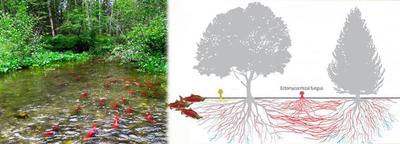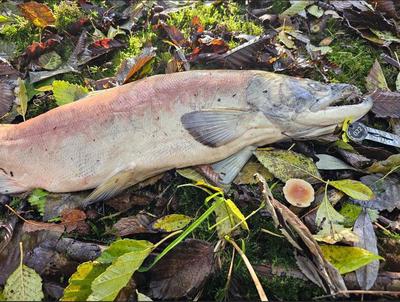Tracing salmon-derived nutrients through riparian systems
The return of Pacific salmon from the ocean allows for the transfer of marine-derived nutrients (MDN) from marine to terrestrial ecosystems. These nutrients enter the riparian ecosystem through direct consumption of carcasses or nutrient assimilation after carcass decomposition. Multiple studies have demonstrated the presence and significance of MDN for animals, plants, and soils. Yet, only one study has examined the effect of MDN on fungi and the significance of fungi as an MDN sink in the soil, and most studies do not consider fungi. However, fungi play a crucial role in nutrient cycling and organic matter decomposition, and many processes are overlooked when tracing the flow of MDN if fungi are not considered.

We examined the effect of a 21-year salmon carcass deposition experiment, and the effect of recent decomposing carcasses, on soil, plant, and fungal δ15N, C:N, and δ13C using stable isotope analysis and genetic sequencing, at one of the most studied salmon stream in the world, located in SW Alaska. We found that fungi uptake and retain MDN in fungal tissue for years following a long-term carcass deposition, suggesting a potentially significant MDN sink in fungi. Carcass deposition significantly decreased C:N in fungal sporocarps and the number of observed fungal sporocarps, indicating that MDN increased %N in fungal tissue and is thus ecologically significant for fungi and riparian functions. Fungi also readily uptake MDN from currently decomposing carcasses, indicating that MDN can be incorporated into fungal tissue within weeks of decomposition. White spruce and paper birch also uptake and retain MDN from long-term carcass deposition, and some MDN is retained in the organic soil layer, indicating that MDN from long-term carcass deposition persists in soil, fungi, and plants for years. Fungal-plant N trading was present across the entire stream, especially between fungi and white spruce, and fungi transferred MDN to plant hosts at the site of carcass deposition. Fractionation during fungal-plant N trading has not been considered for MDN assessments of riparian systems, and this can lead to underestimation of % MDN in plants. The amount of N exchange between fungal and plant hosts decreased at the site of carcass deposition, however, fungal-plant trading increased near recently decomposing carcasses, indicating that short-term nutrient pulses and long-term nutrient deposition could have differing effects on N cycling. The carcass deposition likely increased the availability of phosphorus (P), calcium, and magnesium in the soil, and potentially reduced P limitation. Long-distance and medium-distance fungal foragers, typically not prevalent at sites with high N availability, were the dominant functional groups at the site of carcass deposition uptaking MDN. Some of these genera, such as Paxillus, are specialized for high-N, low-P conditions and could be adept at acquiring P from carcasses. These findings show that MDN from long-term carcass deposition flows through all components of the system – soil, plants, and fungi – of riparian forests, and persists in these components for years, with important ecological implications. This also shows that fungi must be considered for accurate MDN assessment in riparian systems.
